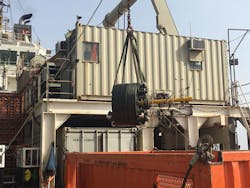Offshore staff
ABERDEEN, UK – STATS Group has completed a program at an unnamed offshore field in the Middle East that involved isolating a 42-in. subsea pipeline.
The dead leg pipeline was housed within an oil storage tank, and the national operating company owner was concerned about the pipe’s integrity after irregular flow characteristics came to light.
Chief worry was that unless the pipeline was successfully isolated, over time the problem would worsen, with the potential for water contamination of the exported oil.
STATS Group had three main issues to address. As the pipeline was constructed of thin wall pipe, it was important that the weight of the isolation plug would not pose a risk, during deployment of rupturing the pipeline.
Secondly, the isolation plug has to provide leak-tight isolation for at least 25 years, so seal material quality was critical.
Finally, the storage tank had to remain fully operational throughout the workscope, which meant that the subsea deployment, setting and testing of the isolation plug had to be conducted by divers within a strict 14-day window.
The 42-in. dead leg is connected to a 96-in. pump plenum housed within the oil storage tank which supplies suction to three topsides pumps and the main 36-in. NB feed transfer line.
STATS’ solution required a secure isolation that could be deployed subsea via divers into the dead leg through an open flange entry point.
The isolation plug would need to negotiate two miter joints and proceed up a 5° incline before reaching its final isolation position 38 m (124 ft) distant, directly ahead of the Plenum weld. The contractor therefore selected a triple seal mechanical isolation plug with the option to remove it at a later date, if needed.
STATS proposed a modified Tecno Plug, a non-intrusive inline isolation tool that has been used widely for pressurized isolation of subsea pipelines in varying sizes and applications.
Due to the dead leg’s thin wall pipe, a standard Tecno Plug would have been too heavy to deploy safely, so the system was re-engineered to reduce the overall weight.
Tecno Plugs feature two elastomeric seals, with the dual seal configuration providing an annulus void that is pressure tested to verify that the seals are leak-tight. On this occasion, the contractor incorporated a third seal into the design, providing the capability to fill the seal annulus with grout if additional sealing were required.
Once the Tecno Plug was deployed and set at location, each seal was leak tested at 110% of the maximum potential isolation pressure, and once the seal integrity was proved, the annulus was vented to ambient to create a zero-energy zone, providing effective double block and bleed isolation.
As an additional fail-safe feature, a mechanical locking mechanism was incorporated. Once the Tecno Plug was hydraulically set and following successful seal integrity tests, it was locked in the set position by means of a ratchet mechanism.
This provided a further mechanical lock in place of the hydraulics to permanently set the plug once abandoned in the pipeline.
So that the device could reach the isolation location, STATS engineered a hydraulically-actuated deployment frame to allow stem bars to be installed in sections, pushing the Tecno Plug to location in a controlled manner.
Once the system has been set and tested, the stem bar deployment system was attached to a specially adapted blind flange and bolted to the open flange, completing the isolation and abandonment workscope within the agreed deadline.
Prior to offshore deployment, STATS also performed a factory acceptance test at its base in Musaffah, Abu Dhabi, which included two days of diver training on a full-scale replica pipe fixture.
02/15/2017



